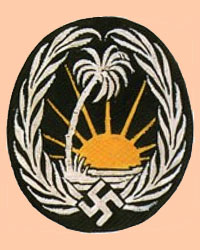Kampfgruppe Menton

Kampfgruppe Menton (Sonderverband 288, Panzer-Grenadier Regiment – Afrika)
- Kampfgruppe = Battle Group
- Sonderverband = Special Unit
Sonderverband or Special Unit 288 was formed in Potsdam, Germany on July 1, 1941. The special unit was drawn from units located throughout Germany and also had a special contingent of German personnel who had lived or had served in what is now South West Asia. The unit was created for a special purpose and as such was not organized along the line of a regular Garman brigade. In total the Sonderverband consisted of 7 to 12 companies with each company having a specialized duty.
Part of the unit were highly specialized personnel. Among these were a company comprised of linguists who were fluent is several Arab and Persians dialects, as well as Urdi, Hindi, and Sanskrit. Most of the people in this company had spent time in the areas (Syria, Iraq, Persia, and India) where the unit was to be deployed. Other non-combat companies included a print shop, a water testing unit, and Brandenburg (commando) Company. The Brandenburg company were to infiltrate enemy lines dressed as the enemy and commit acts of sabotage, gather information and cause other types of havoc.
The other companies were more standardized units. This was also the majority of the personnel. All of the combat companies were crossed trained so that personnel could be shifted from one combat company to another if the need arose. The following companies comprised the rest of the unit.
- Infantry Company
- Gibirgjager (Mountain Infantry) Company
- Reconnaissance Company
- Flak (anti-aircraft) Company
- Artillery company with an SP platoon.
- Anti tank gun Company.
- Engineer Company
- Medical Company
The entire unit was motorized using trucks for transportation. The only tracked armored was found in the SP platoon. The reconnaissance company possessed wheeled armored cars.
Sonderverband 288 was raised shortly after a similar group Sonderverband 287 was formed both units were eventually moved to Greece where they waited the anticipated collapse of British in Egypt. Once the collapse happened the units would deploy to Syria and from there to Iraq and eventually India. The units were suppose to incite rebellion in the British colonies and with the aid of the local populations seize oil fields. This was the planned route for a new southern flank against the Soviet Union.
The plan fell apart when the Germans were stopped in Egypt. Sonderverband 287 was then deployed to Yugoslavia in anti-partisan operations and Sonderverband 288 went to North Africa.
At this time Sonderverband 288 left behind the portion that comprised of linguists and the press shop and other special ops units and was renamed Kampfgruppe Menton. The combat group was also split into two battalions of the three companies each to better fulfill the need of the DAK. The first battalion comprised the infantry elements (mountain, light and reconnaissance) and a heavy battalion (mortars, flak, anti-tank) This independent battle groups was attached to the 90 Leichte (light) Division in defense of El Agheila. It later fought with distinction at Bir-Hachem and Tobruk. On October 31, 1942, the unit was re-designated Panzergrenadier Regiment Afrika and attached to 164 Light Division. It remained attached to the 164 fighting in Tunisia until the eventual collapse of the DAK.
Upon its inception the unit was similar to the LRDG but upon being deployed to North Africa the unit never operated in its intended role. While the unit had a few run-ins with the LRDG this was no different than those of other reconnaissance companies. There is little evidence it was given the mission of chasing down and destroying the LRDG.
When arriving in North Africa, the unit was transformed into a panzergrenadier regiment, trading in its trucks for half tracks. Many of the towed anti-tanks guns were replaced with self propelled guns. Among these weapons were a limited number of Marder III Sd.Kfz.139’s (also called Panzerjager 38 (t)) armed with captured Russian 7.62 cm AT guns (Pak 36). This gun was capable of defeating any allied armor. The unit also acquired the remaining Panzerjäger I’s which were converted Panzer I tanks armed with a Skoda 47 mm PaK L/43 anti-tank gun in open superstructure. The Skoda was an anti-gun of Czech origin. The official name for the Panzerjager I was: Sd.Kfz.101 (4.7cm PaK(t) (Sf) auf Panzerkampfwagen I Ausf B.
The artillery company came with its platoon of Sturmgeschütz III (StuG III) ausf D (Sd.Kfz 142) which were a rarity in North Africa and proved deadly especially in Tunisia. The StuG III ausf D possessed a short barrel 75mm StuK. 37 L/24 cannon firing a HEAT (High-Explosive Anti-tank) round that proved very effective against most British and American armor. Because of the organization of the German Army at this time, StuG III were considered an infantry support weapon and were part of the Artillery. Later StuG III would perform in the roll of tank destroyers and would also equip anti-tank companies.
Mauser machine carbine

Walther machine carbine

All of these are for most likely an AR trial before the ww2 we know that Vollmer also made a machine carbine we have MKB35 in the game which is his design also on one of those Axis weapon suggestions I did suggest Volmer MKB29
